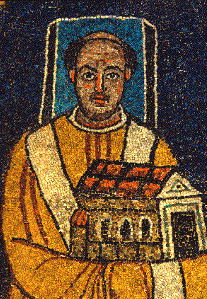Accession
Paschal became pope on 25 January 817, just one day after the sudden death of Stephen IV. [4] This decision was made without the sanction of Emperor Louis the Pious. Paschal began his pontificate apologizing for this slight, stressing that the office had been thrust upon him. [5] He claimed that the decision had been made to avoid factional strife in Rome. According to the Liber Pontificalis, Pope Paschal's legate Theodore returned with a document titled Pactum cum Paschali pontifice, in which the emperor congratulated Paschal, recognized his sovereignty over the Papal States, and guaranteed the free election of future pontiffs. [6] This document has since been challenged by historians as a forgery. [7]
Papacy
At first, Emperor Louis confirmed the agreement reached in Rheims with Paschal's predecessor, Stephen IV, and detailed in the document Pactum Ludovicanum about free papal elections and noninterference in Church affairs unless officially asked for help. The two worked together to send Archbishop Ebbo of Rheims to evangelize the Danes in 822. [5]
On Easter Sunday of 823, Paschal crowned and anointed Louis's son Lothair I. Lothair was less amenable to cooperating with the Papal Curia than his father. He held a court and declared Farfa Abbey, just north of Rome, exempt from papal taxation. Paschal's aristocratic opponents in the papal palace, especially his former legate, Theodore, and his son-in-law, Leo, who turned to the young leader of the Franks for support in their opposition to Paschal. [3] The decision outraged the Roman nobility and led to an uprising against the authority of the Roman Curia in northern Italy led by Theodore and Leo. The revolt was quickly suppressed, and two of its leaders were seized, blinded, and afterwards beheaded by members of the papal household. Paschal denied any involvement, but the Emperor remained suspicious and sent two commissioners to investigate. Paschal refused to submit to the authority of the imperial court, but he did take an oath of purgation before a synod of thirty-four bishops. [5] The commissioners returned to Aachen, and Emperor Louis let the matter drop.
Death
Paschal died on 11 February 824. The Roman Curia refused him the honour of burial within St. Peter's Basilica because of his harsh government of the Roman people. [5] He was instead buried in the Basilica of Santa Prassede, which also contains the famous Episcopa Theodora mosaic of his mother. [17]
Paschal was canonized in the late sixteenth century. His feast day in the Roman calendar prior to 1963 was 14 May. [18] [5] It is currently celebrated on 11 February.
Pope and Patriarch of Rome (817–824), [19] confessor is honored in Orthodox Church on 14 May. [20] [21]
This page is based on this
Wikipedia article Text is available under the
CC BY-SA 4.0 license; additional terms may apply.
Images, videos and audio are available under their respective licenses.

